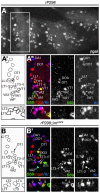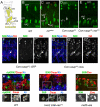Drosophila araucan and caupolican integrate intrinsic and signalling inputs for the acquisition by muscle progenitors of the lateral transverse fate
- PMID: 21811416
- PMCID: PMC3141015
- DOI: 10.1371/journal.pgen.1002186
Drosophila araucan and caupolican integrate intrinsic and signalling inputs for the acquisition by muscle progenitors of the lateral transverse fate
Abstract
A central issue of myogenesis is the acquisition of identity by individual muscles. In Drosophila, at the time muscle progenitors are singled out, they already express unique combinations of muscle identity genes. This muscle code results from the integration of positional and temporal signalling inputs. Here we identify, by means of loss-of-function and ectopic expression approaches, the Iroquois Complex homeobox genes araucan and caupolican as novel muscle identity genes that confer lateral transverse muscle identity. The acquisition of this fate requires that Araucan/Caupolican repress other muscle identity genes such as slouch and vestigial. In addition, we show that Caupolican-dependent slouch expression depends on the activation state of the Ras/Mitogen Activated Protein Kinase cascade. This provides a comprehensive insight into the way Iroquois genes integrate in muscle progenitors, signalling inputs that modulate gene expression and protein activity.
Conflict of interest statement
The authors have declared that no competing interests exist.
Figures








Similar articles
-
Prepatterning the Drosophila notum: the three genes of the iroquois complex play intrinsically distinct roles.Dev Biol. 2008 May 15;317(2):634-48. doi: 10.1016/j.ydbio.2007.12.034. Epub 2008 Jan 4. Dev Biol. 2008. PMID: 18394597
-
The activity of the Drosophila Vestigial protein is modified by Scalloped-dependent phosphorylation.Dev Biol. 2017 May 1;425(1):58-69. doi: 10.1016/j.ydbio.2017.03.013. Epub 2017 Mar 18. Dev Biol. 2017. PMID: 28322734
-
Combinatorial coding of Drosophila muscle shape by Collier and Nautilus.Dev Biol. 2012 Mar 1;363(1):27-39. doi: 10.1016/j.ydbio.2011.12.018. Epub 2011 Dec 20. Dev Biol. 2012. PMID: 22200594
-
Cellular analysis of newly identified Hox downstream genes in Drosophila.Eur J Cell Biol. 2010 Feb-Mar;89(2-3):273-8. doi: 10.1016/j.ejcb.2009.11.012. Epub 2009 Dec 16. Eur J Cell Biol. 2010. PMID: 20018403 Review.
-
Diversification of muscle types in Drosophila embryos.Exp Cell Res. 2022 Jan 1;410(1):112950. doi: 10.1016/j.yexcr.2021.112950. Epub 2021 Nov 26. Exp Cell Res. 2022. PMID: 34838813 Review.
Cited by
-
Org-1, the Drosophila ortholog of Tbx1, is a direct activator of known identity genes during muscle specification.Development. 2012 Mar;139(5):1001-12. doi: 10.1242/dev.073890. Development. 2012. PMID: 22318630 Free PMC article.
-
Specification of the somatic musculature in Drosophila.Wiley Interdiscip Rev Dev Biol. 2015 Jul-Aug;4(4):357-75. doi: 10.1002/wdev.182. Epub 2015 Feb 27. Wiley Interdiscip Rev Dev Biol. 2015. PMID: 25728002 Free PMC article. Review.
-
A taxon-restricted duplicate of Iroquois3 is required for patterning the spider waist.PLoS Biol. 2024 Aug 29;22(8):e3002771. doi: 10.1371/journal.pbio.3002771. eCollection 2024 Aug. PLoS Biol. 2024. PMID: 39208370 Free PMC article.
-
Contribution of distinct homeodomain DNA binding specificities to Drosophila embryonic mesodermal cell-specific gene expression programs.PLoS One. 2013 Jul 26;8(7):e69385. doi: 10.1371/journal.pone.0069385. Print 2013. PLoS One. 2013. PMID: 23922708 Free PMC article.
-
Whole-genome analysis of muscle founder cells implicates the chromatin regulator Sin3A in muscle identity.Cell Rep. 2014 Aug 7;8(3):858-70. doi: 10.1016/j.celrep.2014.07.005. Epub 2014 Jul 31. Cell Rep. 2014. PMID: 25088419 Free PMC article.
References
-
- Bate M. The mesoderm and its derivatives; In: Martinez-Arias MBaA., editor. Cold Spring Harbor, New York: CHS Laboratory Press; 1993. pp. 1013–1090.
-
- Baylies MK, Bate M, Ruiz Gomez M. Myogenesis: a view from Drosophila. Cell. 1998;93:921–927. - PubMed
-
- Carmena A, Bate M, Jimenez F. Lethal of scute, a proneural gene, participates in the specification of muscle progenitors during Drosophila embryogenesis. Genes Dev. 1995;9:2373–2383. - PubMed
Publication types
MeSH terms
Substances
LinkOut - more resources
Full Text Sources
Molecular Biology Databases
Research Materials

